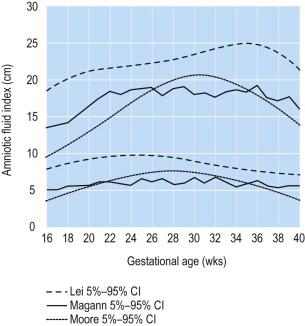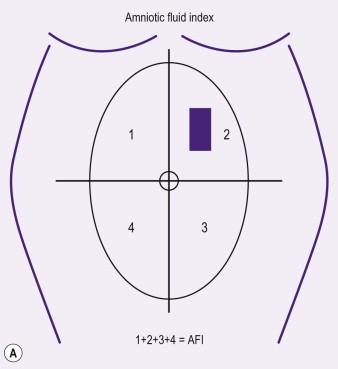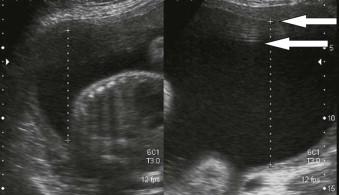Physical Address
304 North Cardinal St.
Dorchester Center, MA 02124
Amniotic fluid (AF) is an essential complex and dynamic environment that changes in nature and amount as pregnancy progresses. Amniotic fluid surrounds the fetus during intrauterine development and normal levels are essential to fetal well-being. The presence of normal amniotic fluid throughout gestation not only allows for normal development of the fetal respiratory and musculoskeletal systems, development and maturation of the gastrointestinal and urinary tracts as well as continued fetal growth in a sterile and thermally controlled environment, it also reflects fetal and maternal health throughout gestation.
The amount of amniotic fluid present, i.e. amniotic fluid volume is:
gestational-age dependent;
maintained within a normal range;
highly regulated.
Disorders of amniotic fluid volume reflect both fetal health and perinatal outcome. Both deficient (oligohydramnios) and excess liquor (polyhydramnios) conditions are associated with increased perinatal morbidity and mortality. A thorough understanding of the mechanisms of amniotic production and regulation are fundamental to the appropriate management of these conditions. It is only by understanding how amniotic fluid is produced and regulated that ultrasound will determine the underlying cause of amniotic fluid abnormalities.
Liquor volume will be discussed under the following headings:
Normal conditions and the mechanisms responsible for the dynamics of amniotic fluid volume.
Ultrasound evaluation of amniotic fluid volume: the techniques used for measurement.
The pathological states of:
oligohydramnios;
polyhydramnios;
particulate amniotic fluid.
One single factor does not control amniotic fluid volume which in part explains the wide variations in normal amniotic fluid volume between fetuses of the same gestational age, as shown in Figure 4-1 .

The pathways described below are those of amniotic fluid regulation from 12 weeks onwards. Prior to that gestational age, the fluid within the amniotic cavity is thought to be due to passive transfer of fluid across the amniotic membranes from the chorionic cavity. Before 20 weeks’ gestation the fluid is isotonic and its composition approximates to maternal plasma.
After keratinization of the fetal skin begins at 19 weeks, AF volume is determined by factors that comprise the AF circulation, a term which is used to describe the pathways of exchange between the amniotic space and the fetal and placental tissues ( Table 4-1 ).
| Principal Pathways Contributing to the Production of Amniotic Fluid | |
| Fetal urination | 800–1200 mL/day |
| Respiratory tract fluid | 10 mL/day |
| Oral secretions | 170 mL/day |
| Trans-membranous across the cord and the placenta | ? 25 mL/day |
| Principal Pathways Contributing to Removal of Fluid from the Amniotic Cavity | |
| Fetal swallowing | 500–1000 mL/day |
| Intra-membranous | 200–500 mL |
| Respiratory tract fluid | 170 mL |
Production of AF is accomplished by:
Excretion of fetal urine (this will amount to about 300 mL/kg fetal weight/day or 800 to 1200 mL/day near term). The production of fetal urine begins at approximately 10 weeks’ gestation. There is a directly proportional linear production of urine with increasing gestational age, with accelerated production after 32 weeks.
Secretion of oral, nasal, tracheal, and pulmonary fluids (which amounts to 60 to 100 mL/kg fetal weight/day).
Removal of AF is accomplished by:
Fetal swallowing of approximately 200 to 250 mL/kg fetal weight/day. Swallowing by the fetus begins almost simultaneously with fetal urination and by late pregnancy swallowing of volumes of 450 to 1500 mL/day have been reported.
The intramembranous pathway is believed to be the mechanism which compensates for the normal excess of about 400 mL in the amniotic cavity when the total amount of fluid removed by swallowing is subtracted from the total amount of fluid produced by fetal urine and secreted fetal fluid.
The intramembranous pathway refers to the movement of water and solutes into the fetal circulation across the fetal vessels on the surface of the placenta, due to an osmotic difference between the fetal circulation and the amniotic fluid.
There is a strong relationship between the maternal fluid status and fluid balance within the fetal circulation and the AFV. It is likely that it is via the intramembranous pathway that fetal volume status is maintained at normal levels during times of maternal dehydration. Kilpatrick et al. showed that maternal hydration with 2 L of water in a patient with a low AFV can increase the human fetal amniotic fluid index (AFI) by up to 31%.
The actual importance of the transmembranous pathway as a major contributor to the AFV in the second half of pregnancy is highly questionable. It is obvious why this mechanism has been proposed to regulate amniotic fluid volume, but knowledge of this pathway remains deficient.
Amniotic fluid volume regulation is maintained by the delicate balance between production, essentially by fetal urine and to a lesser extent lung secretion, and removal by swallowing and intramembranous absorption of fluid in the amniotic cavity. Several studies demonstrate that despite apparent inequalities, in that the amount removed by fetal swallowing is smaller than that produced by fetal urination, amniotic fluid volume remains in a fairly stable equilibrium. The relative stability of AF volume in spite of large fluid shifts suggests that control mechanisms do exist which take on a greater importance in some fetuses with certain abnormalities. For example, only half of fetuses with oesophageal atresia, and two-thirds of fetuses with duodenal or proximal jejunal atresia develop polyhydramnios. This must mean that other mechanisms besides swallowing are involved in AF volume regulation and the intramembranous pathway must be the means of compensation which explains these fluid anomalies.
The most accurate methods for determining total amniotic fluid volume are direct measurements at the time of hysterotomy and dye-dilution techniques, neither of which is clinically applicable; however historically they do represent a reference allowing for evaluation of the accuracy of all other ultrasound measurements of AFV.
The most clinically relevant method should be the one which best determines the volume of amniotic fluid associated with adverse outcome rather than one that best calculates volume abnormalities outside a normal range, i.e. a method of measurement which measures for example a 95% confidence interval for gestational age may not be of use in the everyday clinical setting.
The fact that there are so many different techniques is an indicator of the inaccuracies inherent in each of the methods of measurement and each different modality will have different cut-off threshold points for the diagnosis of low and high amniotic fluid levels. This will have implications in clinical practice, reporting between department and centres and when comparing studies.
The single deepest pocket (SDP) measurement refers to the vertical dimension of the largest pocket of amniotic fluid which must not contain umbilical cord or fetal extremities and which is measured at a right angle to the uterine contour. This naturally requires an assessment of the entire cavity before measurement.
Using an SDP measurement the following definitions apply:
Oligohydramnios: depth of 0 to 2 cm.
Normal: depth of 2.1 to 8 cm.
Polyhydramnios: depth greater than 8 cm.
The amniotic fluid index (AFI) measurement is calculated by first dividing the uterus into four quadrants using the linea nigra for the right and left divisions and the umbilicus for the upper and lower quadrants ( Figure 4-2 A and B ). The maximum vertical amniotic fluid pocket diameter in each quadrant is measured in centimetres; the sum of these measurements is the AFI. Each quadrant pool must again be free of umbilical cord and fetal parts.

Using the AFI the following definitions apply:
Oligohydramnios: 0 to <5 cm.
Normal: 5 to 25 cm.
Polyhydramnios: greater than 25 cm.
This has always been considered the most robust method but an abnormal AFI has, however, been shown to be neither accurate nor predictive of adverse outcome. The AFI will falsely diagnose many normal pregnancies as abnormal and a large number with truly abnormal amniotic fluid volumes will be missed.
Subjective assessment of amniotic fluid volume refers to visual interpretation by the ultrasonographer without sonographic measurements, and it has been accepted that this method performed by an experienced practitioner performs well, particularly in cases of normal liquor volume. The subjective method of assessment does not allow for comparison between different practitioners monitoring the same pregnancy, nor does it allow accurate comparative monitoring of a changing condition. The subjective technique and all quantitative ultrasound methods determine low and high volumes poorly.
The measurement of the amniotic fluid in diamniotic twin pregnancies is even more inaccurate than in singleton gestations because the position of the dividing membrane affects the interpretation of the pool to be measured.
All three methods have similar inaccuracies when used for multiple gestations as for singleton pregnancies.
None of the methods used to assess the amniotic fluid level are very accurate or more importantly without harm. The diagnosis of oligohydramnios may lead to intervention with acknowledged increased rates of induction of labour and increased Caesarean section rates following on a diagnosis of third trimester oligohydramnios. Such intervention has not shown an overall improvement in perinatal outcome.
In clinical practice the measurement of amniotic fluid volume, either the AFI or SDP, is not a measurement that should ever used in isolation. It should be used as part of the clinical evaluation of the patient and involve additional sonographic assessment (e.g., biophysical profile, non-stress test, ultrasound examination for estimated fetal weight, anatomic survey etc) in an appropriate clinical scenario, i.e. the management of a complicated pregnancy.
In our practice a subjective assessment of amniotic fluid volume is part of all ultrasound examinations. If the liquor is suspected to be abnormal then an objective measurement is performed. This allows for comparison and monitoring of a changing condition and allows for shared monitoring between the ultrasound department, antenatal day unit and labour and delivery wards.
On the basis of multiple reviews it would seem that whilst practitioners do favour the AFI, this method does lead to over-diagnosis of oligohydramnios and an increase in the number of labour inductions and Caesarean deliveries. The method considered now to be most accurate, which can also be used with just as much ‘accuracy’ in multiple as in singleton gestations is the single deepest pool (SPD).
The reports are conflicting but the key points on analysis seem to be:
The AFI is more likely to lead to a false-positive diagnosis of oligohydramnios.
The method chosen within a unit should be uniform, i.e. all practitioners should use the same technique and the agreed technique must be used in all hospital departments.
It cannot be emphasized enough that the definition for the quantitative assessment of normal and abnormal amniotic fluid must be consistent not only within departments and units but also within the pertinent literature. The degree of variability quoted can be very worrying.
The amniotic fluid measurement is only one part of an assessment with fetal biometry; a detailed anatomical survey and Doppler evaluation are all part of the process of diagnosis of a complicated pregnancy.
No technique for measurement of amniotic fluid volume is ideal, but whatever method is used it must be obtained accurately and reported in the setting of a well-conducted assessment of the entire pregnancy as a whole.
All of the quantitative methods of amniotic fluid measurement involve in part a similar technique in that for the measurement of the pool of fluid the probe must be held perpendicular to the floor. A vertical measurement is made from the inner edge of the anterior uterine cavity to the interior edge of the posterior part of the uterine cavity. Care must be taken to establish the inner edge very clearly and not to include reverberation artefact ( Figure 4-3 ). This mistake potentiated throughout all four measurements in the AFI could produce a very significant error!

Become a Clinical Tree membership for Full access and enjoy Unlimited articles
If you are a member. Log in here